CHEVROLET ASTRO 1997 2.G Owners Manual
Manufacturer: CHEVROLET, Model Year: 1997, Model line: ASTRO, Model: CHEVROLET ASTRO 1997 2.GPages: 404, PDF Size: 20.63 MB
Page 291 of 404
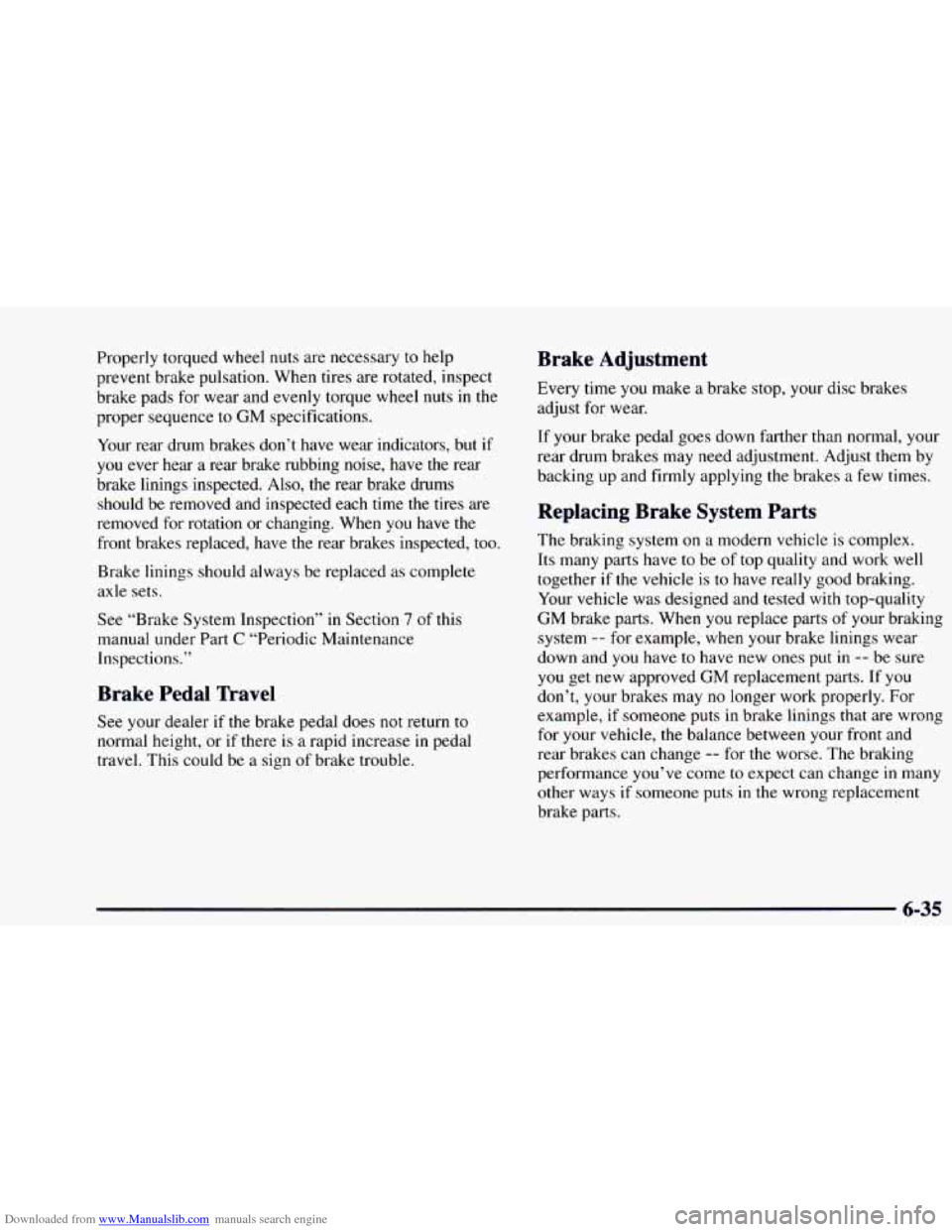
Downloaded from www.Manualslib.com manuals search engine Properly torqued wheel nuts are necessary to help
prevent brake pulsation. When tires are rotated, inspect
brake pads for wear and
evenly torque wheel nuts in the
proper sequence
to GM specifications.
Your rear drum brakes don’t have wear indicators, but
if
you ever hear a rear brake rubbing noise, have the rear
brake linings inspected. Also,
the rear brake drums
should be removed and inspected each time the tires are
removed for rotation or changing. When
you have the
front brakes replaced, have the rear brakes inspected, too.
Brake linings should always be replaced as complete
axle sets.
See “Brake System Inspection’’ in Section
7 of this
manual under Part
C “Periodic Maintenance
Inspections.”
Brake Pedal Travel
See your dealer if the brake pedal does not return to
normal height, or if there is a rapid increase
in pedal
travel. This could be a sign of brake trouble.
Brake Adjustment
Every time you make a brake stop, your disc brakes
adjust for wear.
If your brake pedal goes down farther than normal, your
rear drum brakes may need adjustment. Adjust them by
backing up and firmly applying the brakes a few times.
Replacing Brake System Parts
The braking system on a modern vehicle is complex.
Its many parts have to be
of top quality and work well
together if the vehicle is to have really good braking.
Your vehicle was designed and tested with top-quality
GM brake parts. When
you replace parts of your braking
system
-- for example, when your brake linings wear
down and you have to have new ones put
in -- be sure
you get new approved GM replacement parts. If you
don’t, your brakes may
no longer work properly. For
example,
if someone puts in brake linings that are wrong
for your vehicle,
the balance between your front and
rear brakes can change
-- for the worse. The braking
performance you’ve come to expect can change
in many
other ways
if someone puts in the wrong replacement
brake parts.
6-35
Page 292 of 404
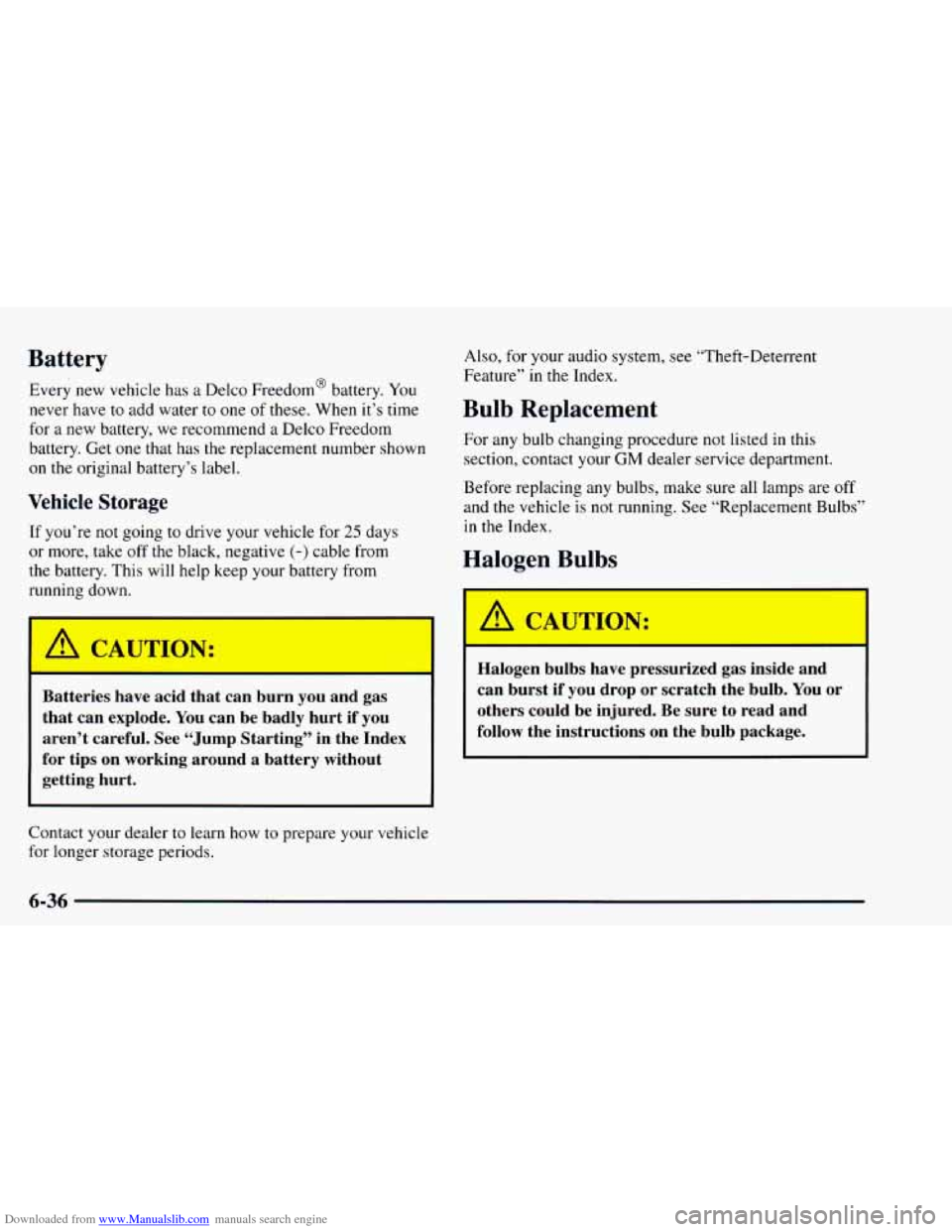
Downloaded from www.Manualslib.com manuals search engine Battery
Every new vehicle has a Delco Freedom@ battery. You
never have to add water to one of these. When it’s time
for a new battery, we recommend a Delco Freedom
battery. Get one that has
the replacement number shown
on the original battery’s label.
Vehicle Storage
If you’re not going to drive your vehicle for 25 days
or more, take off the black, negative
(-) cable from
the battery. This will help keep your battery from
running down. Also,
for your audio system, see “Theft-Deterrent
Feature” in the Index.
Bulb Replacement
For any bulb changing procedure not listed in this
section, contact your
GM dealer service department.
Before replacing any bulbs, make sure all lamps are
off
and the vehicle is not running. See “Replacement Bulbs”
in the Index.
Halogen Bulbs
Batteries have acid that can burn you and gas
that can explode.
You can be badly hurt if you
aren’t careful. See “Jump Starting” in the Index
for tips on working around a battery without getting hurt.
Contact your dealer to learn how
to prepare your vehicle
for longer storage periods.
I A CAUTION:
I
Halogen bulbs have pressurized gas inside and
can burst if you drop or scratch the bulb.
You or
others could be injured. Be sure to read and
follow the instructions on the bulb package.
6-36
Page 293 of 404
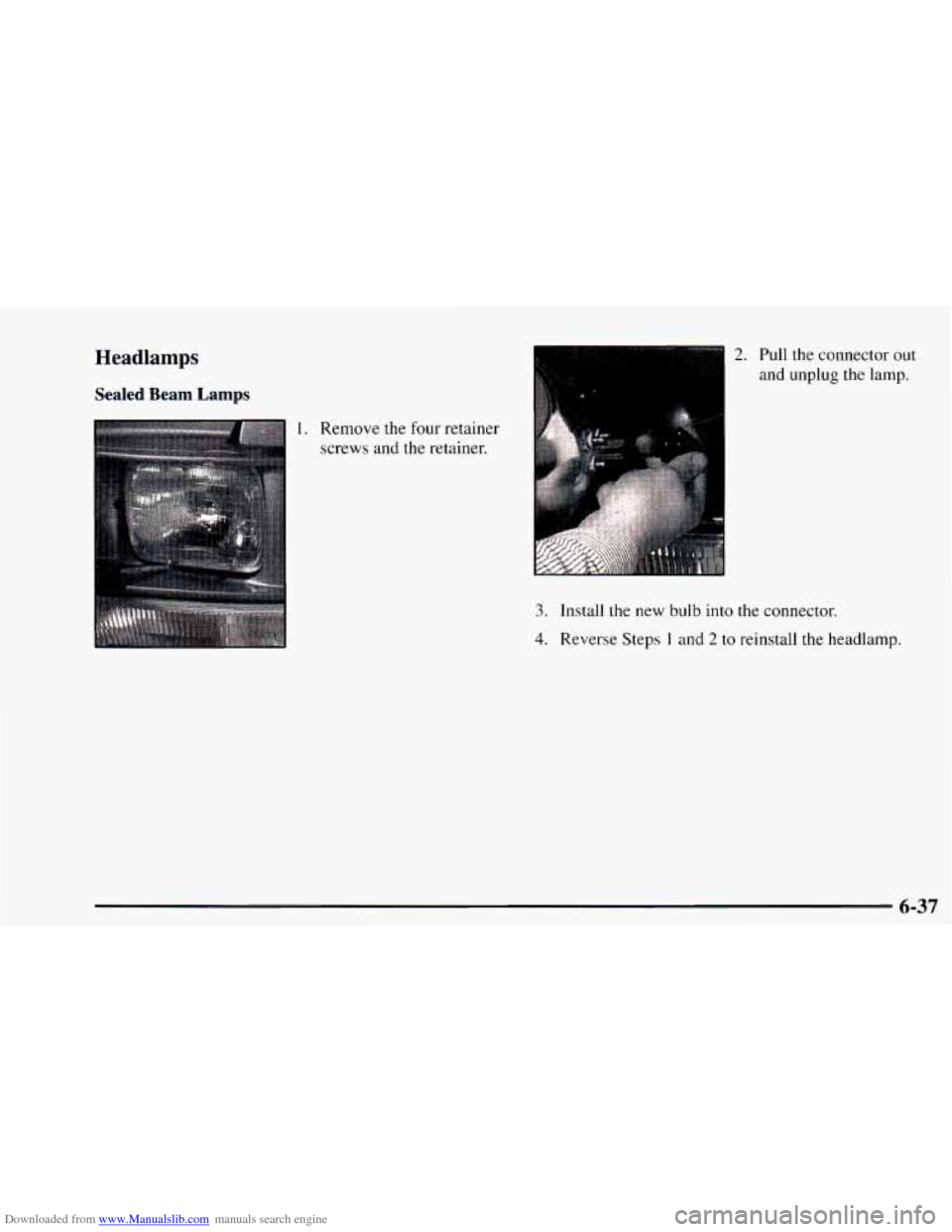
Downloaded from www.Manualslib.com manuals search engine Headlamps
Sealed Beam Lamps
1. Remove the four retainer
screws and
the retainer.
2. Pull the connector out
and unplug the lamp.
3. Install the new bulb into the connector.
4. Reverse Steps 1 and 2 to reinstall the headlamp.
6-37
Page 294 of 404
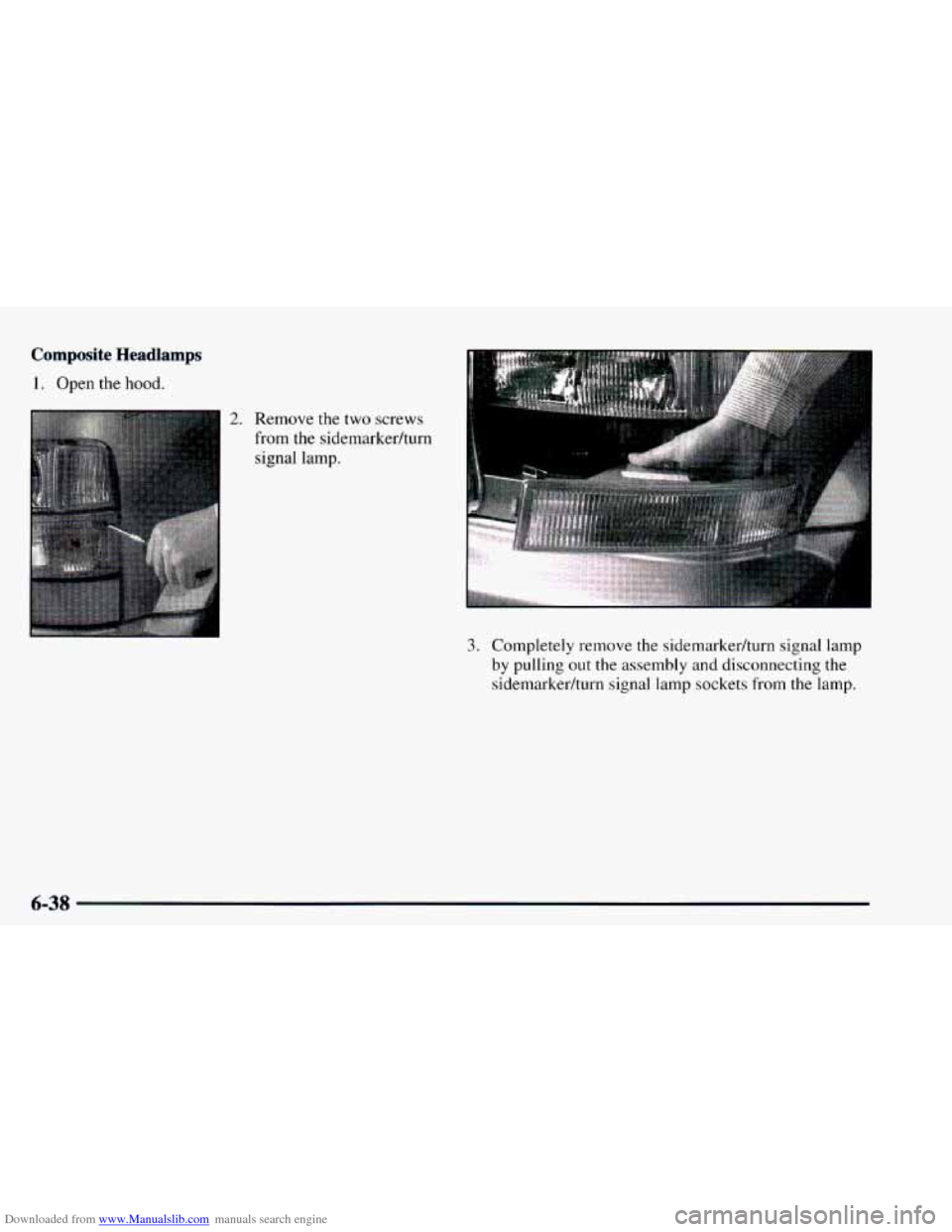
Downloaded from www.Manualslib.com manuals search engine Composite Headlamps
1. Open the hood.
3. Completely remove the sidemarkedturn signal lamp
by pulling out the assembly and disconnecting the
sidemarkedturn signal lamp sockets from the lamp.
6-38
Page 295 of 404
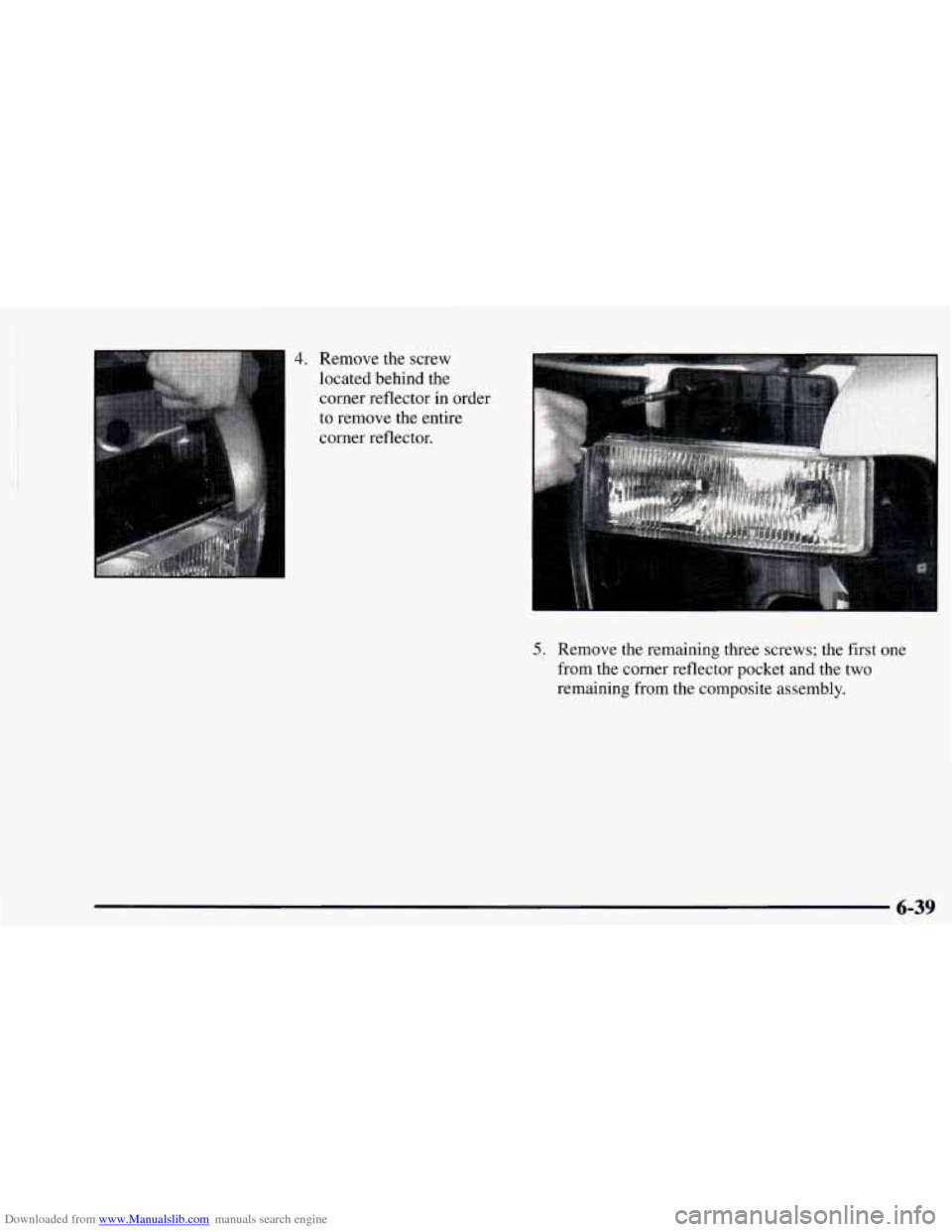
Downloaded from www.Manualslib.com manuals search engine 4. Remove the screw
located behind the
corner reflector in order
to remove the entire
corner reflector.
5. Remove the remaining three screws; the first one
from the corner reflector pocket and the two
remaining from the composite assembly.
6-39
Page 296 of 404
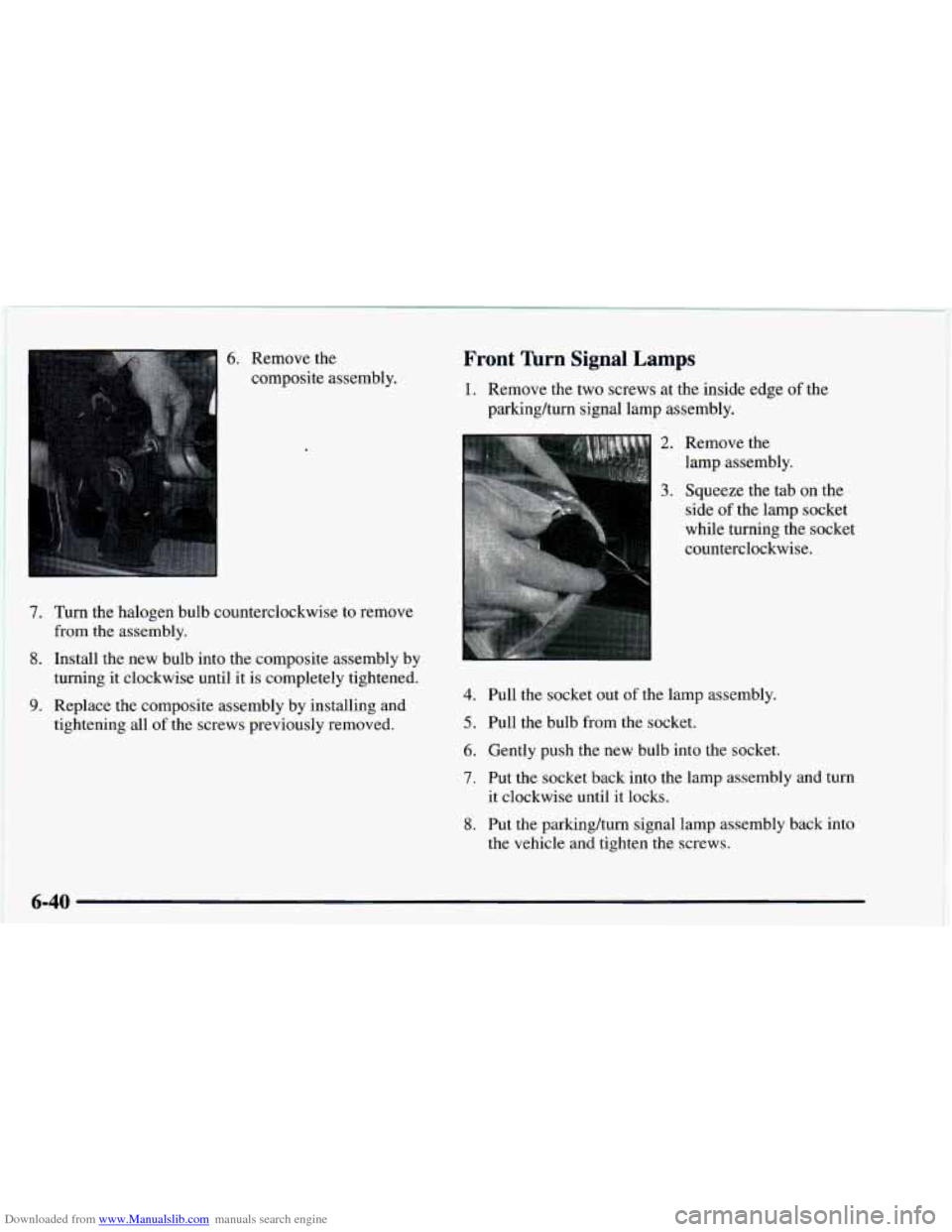
Downloaded from www.Manualslib.com manuals search engine 6. Remove the
composite assembly.
7. Turn the halogen bulb counterclockwise to remove
8. Install the new bulb into the composite assembly by
turning
it clockwise until it is completely tightened.
tightening all
of the screws previously removed.
from the assembly.
9. Replace the composite assembly by installing and
Front Turn Signal Lamps
1. Remove the two screws at the inside edge of the
parking/turn signal lamp assembly.
2. Remove the
lamp assembly.
3. Squeeze the tab on the
side
of the lamp socket
while turning the socket
counterclockwise.
4. Pull the socket out of the lamp assembly.
5. Pull the bulb from the socket.
6. Gently push the new bulb into the socket.
7. Put the socket back into the lamp assembly and turn
it clockwise until it locks.
8. Put the parkinghrn signal lamp assembly back into
the vehicle and tighten the screws.
6-40
Page 297 of 404
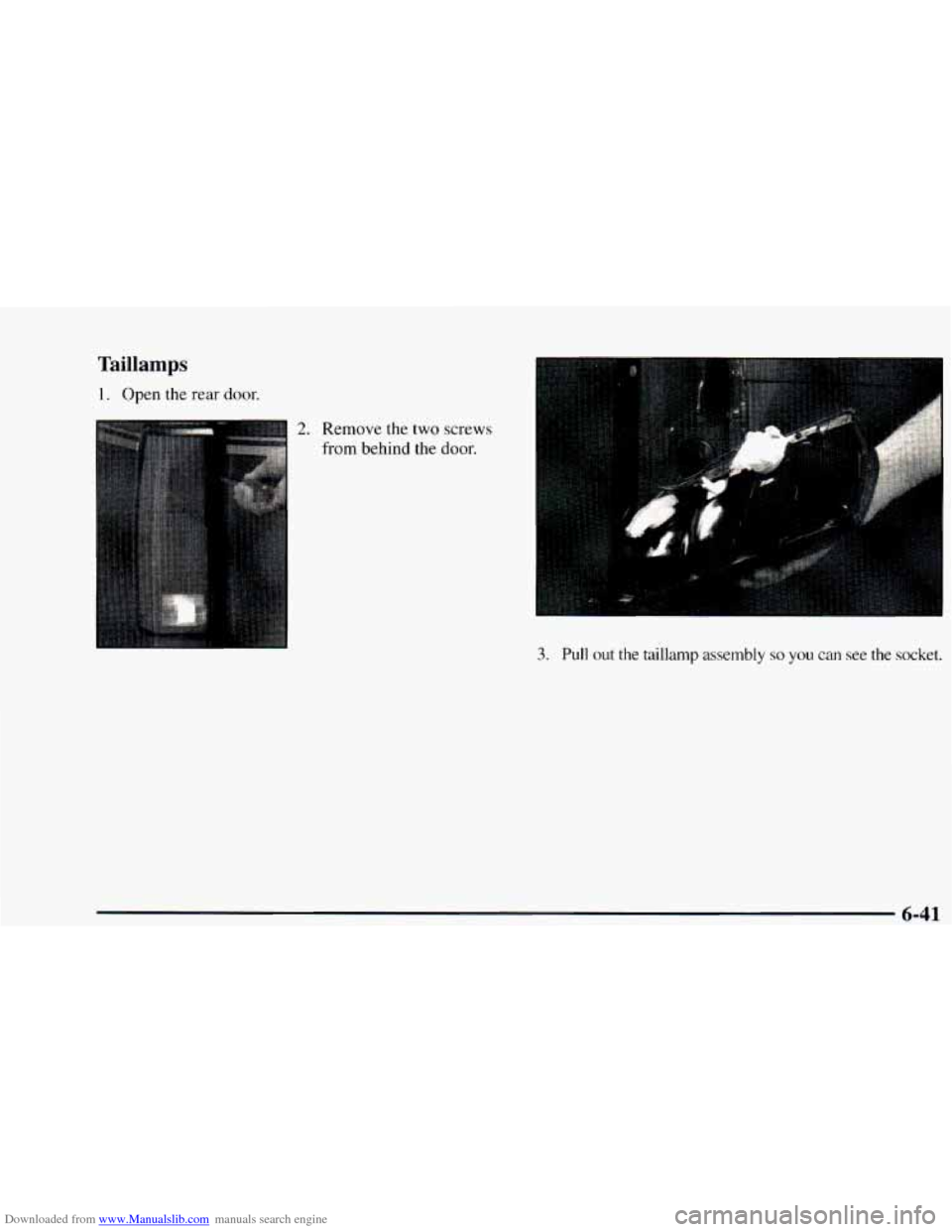
Downloaded from www.Manualslib.com manuals search engine Taillamps
1. Open the rear door.
2. Remove the two screws
from behind the door.
3. Pull out the taillamp assembly so you can see the socket.
6-41
Page 298 of 404
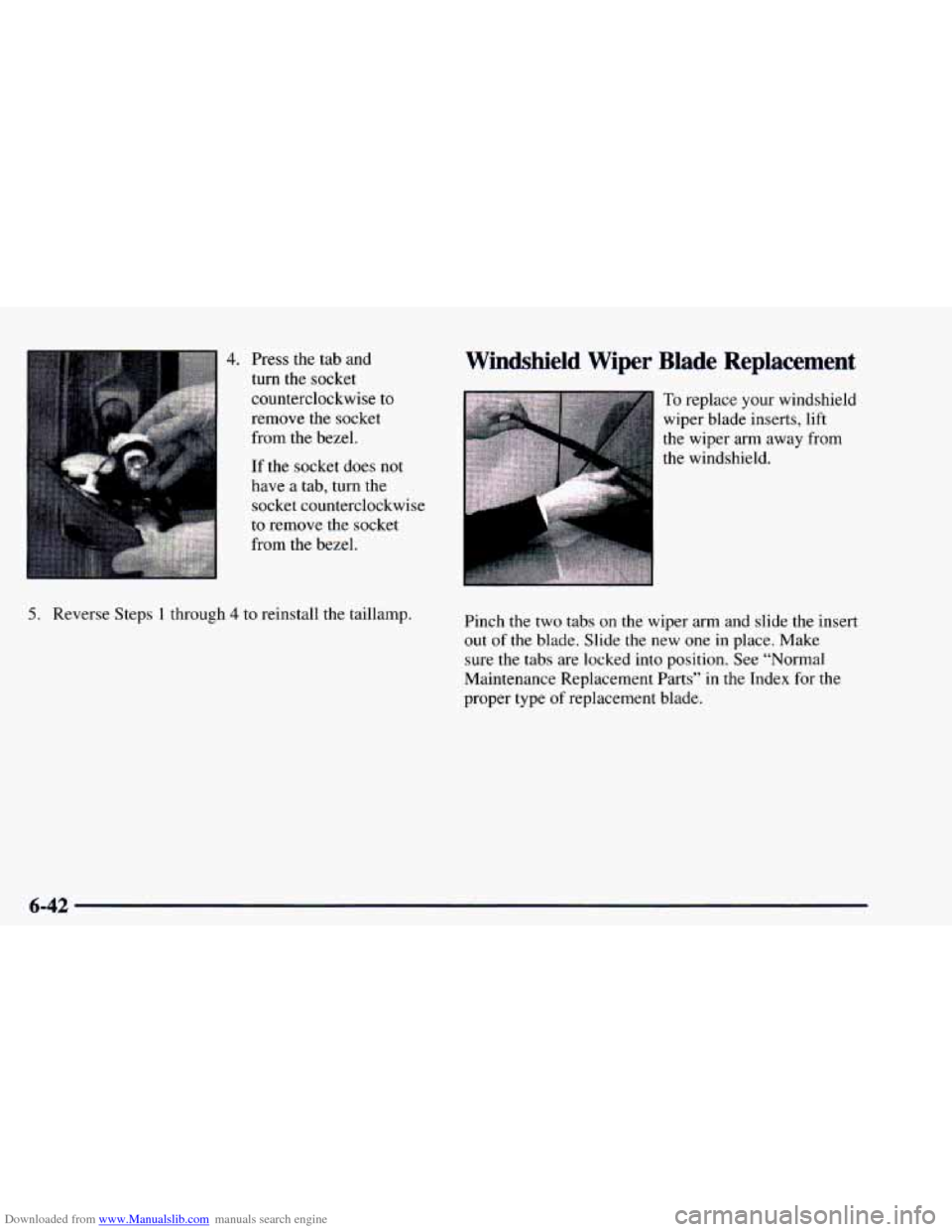
Downloaded from www.Manualslib.com manuals search engine 4. Press the tab and
turn the socket
counterclockwise
to
remove the socket
from the bezel.
If the socket does not
have a tab, turn the
socket counterclockwise
to remove the socket
from the bezel.
Windshield Wiper Blade Replacement
To replace your windshield
wiper blade inserts, lift
the wiper arm away from the windshield.
5. Reverse Steps 1 through 4 to reinstall the taillamp.
Pinch the two tabs on the wiper arm and slide the insert
out of the blade. Slide
the new one in place. Make
sure the tabs are locked into position. See “Normal
Maintenance Replacement Parts”
in the Index for the
proper type of replacement blade.
6-42
Page 299 of 404
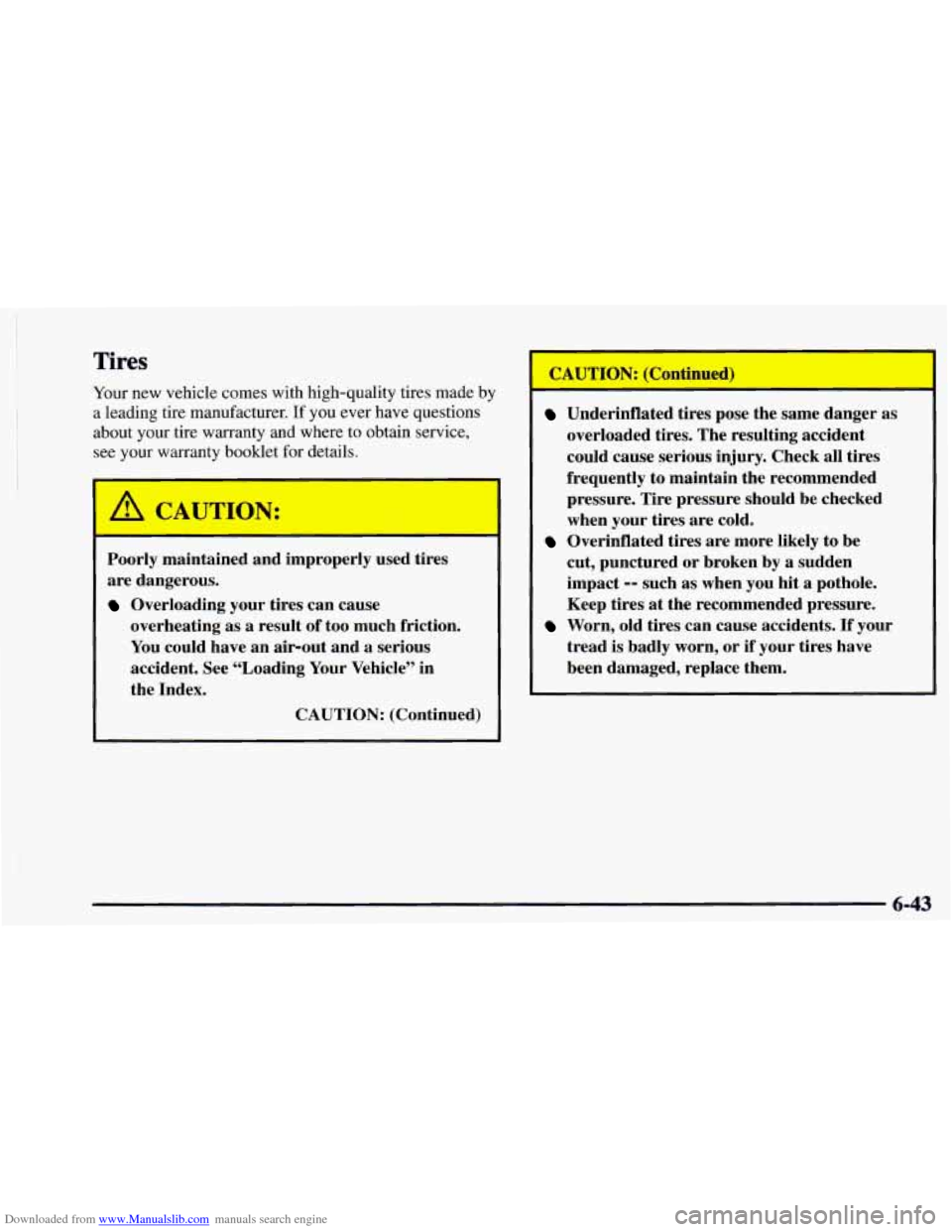
Downloaded from www.Manualslib.com manuals search engine Tires
Your new vehicle comes with high-quality tires made by
a leading tire manufacturer. If you ever have questions
about your tire warranty and where to obtain service,
see your warranty booklet for details.
I
1
Poorly maintained and improperly used tires
are dangerous.
Overloading your tires can cause
overheating
as a result of too much friction.
You could have an air-out and a serious
accident. See “Loading Your Vehicle” in
the Index.
CAUTION: (Continued)
Underinflated tires pose the same danger as
overloaded tires. The resulting accident
could cause serious injury. Check all tires
frequently to maintain the recommended
pressure. Tire pressure should be checked
when your tires are cold.
cut, punctured or broken by a sudden
impact
-- such as when you hit a pothole.
Keep tires at the recommended pressure.
Worn, old tires can cause accidents. If your
tread is badly worn, or if your tires have
been damaged, replace them.
Overinflated tires are more likely to be
6-43
Page 300 of 404
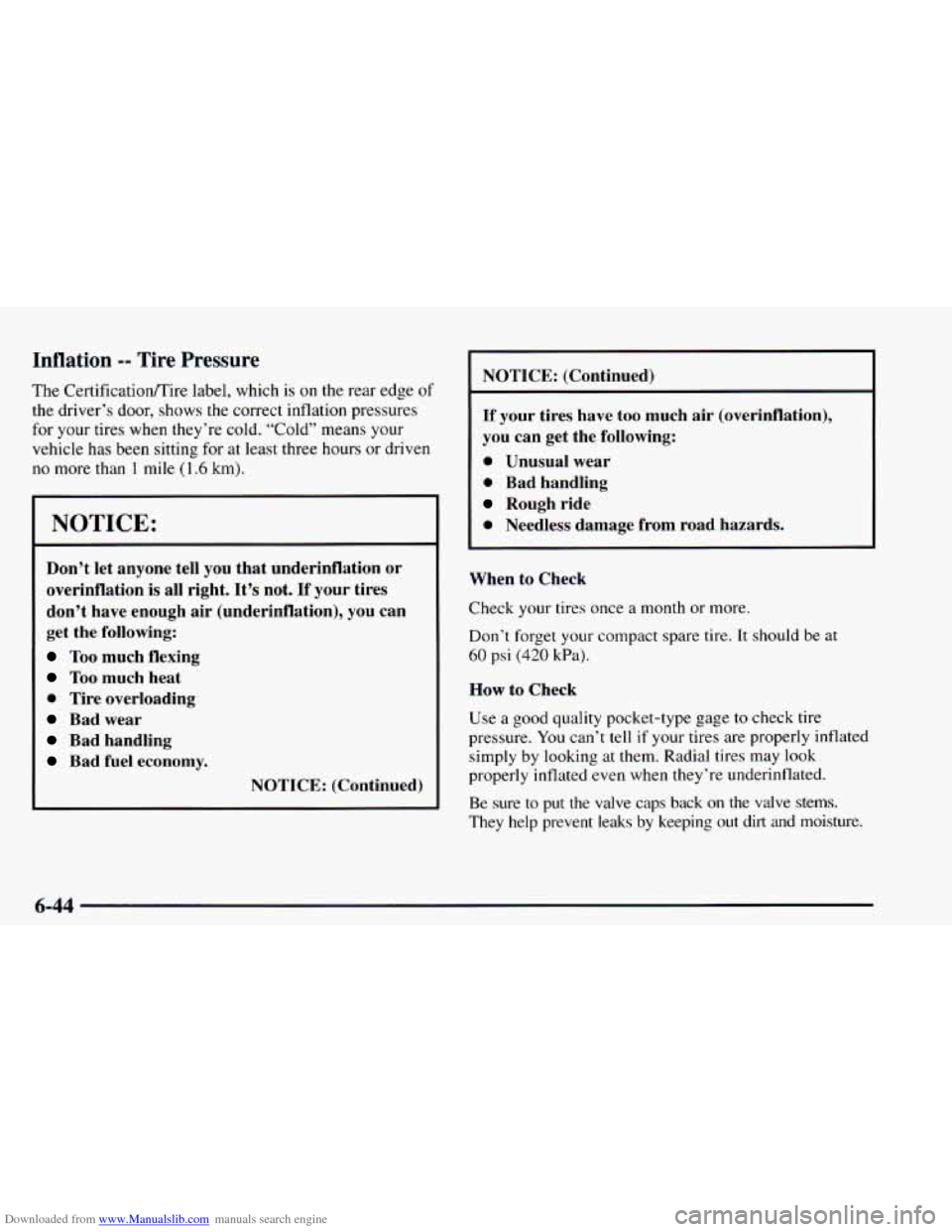
Downloaded from www.Manualslib.com manuals search engine Inflation -- Tire Pressure
The CertificationRire label, which is on the rear edge of
the driver’s door, shows the correct inflation pressures
for your
tires when they’re cold. “Cold” means your
vehicle has been sitting for at least three hours or driven
no more than
1 mile (1.6 km).
NOTICE:
Don’t let anyone tell you that underinflation or
overinflation is all right.
It’s not. If your tires
don’t have enough
air (underinflation), you can
get the following:
Too much flexing
Too much heat
0 Tire overloading
Bad wear
Bad handling
Bad fuel economy.
NOTICE: (Continued) NOTICE: (Continued)
If your tires have too much air
(overinflation),
you can get the following:
0 Unusual wear
0 Bad handling
Rough ride
0 Needless damage from road hazards.
When
to Check
Check your tires once a month or more.
Don’t forget your compact spare tire.
It should be at
60 psi (420 kPa).
How to Check
use a
good quality pocket-type gage to check tire
pressure.
You can’t tell if your tires are properly inflated
simply by looking at them. Radial tires may look
properly inflated even when they’re underinflated.
Be sure to put the valve caps back
on the valve stems.
They help prevent leaks by keeping
out dirt and moisture.
6-44